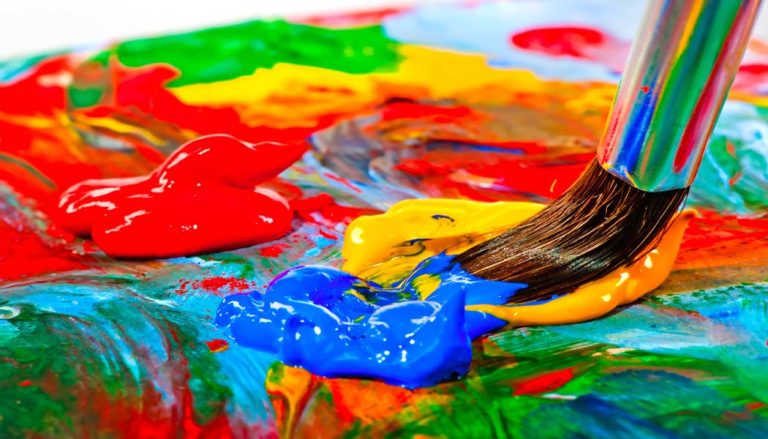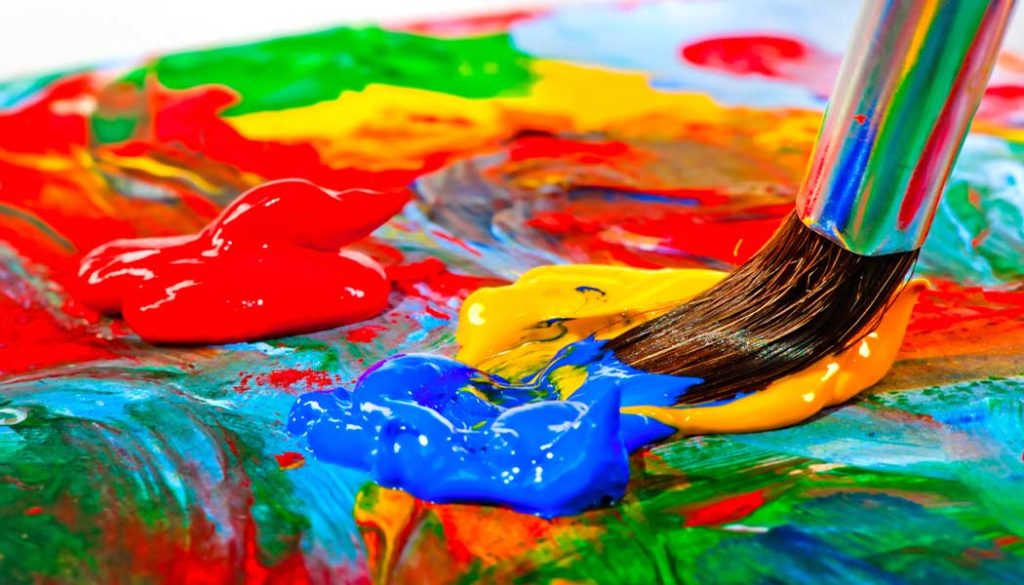
Do You Wet the Brush before Using Acrylic Paint?
You know that acrylic paint comes with so many benefits. It’s opaque, easy to use and clean, and it can be used in numerous projects including indoor and outdoor. So, you have planned to paint something with acrylic paint and some questions in your mind make you really confused.
One of the questions can be like ‘do you wet the brush before using acrylic paint’. Well, we’re here to give you in-depth idea about using paintbrush for acrylic paint. Do you need to wet it or not?

Normally, you don’t need to wet your paintbrush to paint with acrylic paint. To ensure smooth flow on the surface, you can use a little bit of water to wet the brush. Sometimes, a damp paintbrush helps to get your planned style on the surface.
To know more, keep reading the following guide.
Do You Wet the Brush before Using Acrylic Paint?
There are several types of paints available. Thus, not all types require the brush to be wet before applying the paint. However, acrylic paint to some extent does require the brush to be damp beforehand.
Now there is a bit of difference between being wet and damp. When you soak the paint brush in water it gets wet. But you have to remove the excess water first. Thus, when you remove the excess water, the brush becomes damp.
Nonetheless, there are several degrees of wetness of paint brush. Hence, you need to know first how wet the brush should be for applying acrylic paint.
However, acrylic paint requires its brushes to be damp with no excess water. Now you might ask how this damp paint brush works for painting. The answer is very direct and simple! A damp paint brush works better for transferring the paint from the brush to the project.
Moreover, it makes the application a lot easier. Also, it offers a smooth finish after painting. You can still, however, use acrylic paint with a dry brush. But you will see there is a drastic difference between the two applications.
Problems You Might Face for Using Dry Brush for Acrylic Paint
No doubt, you can use dry brush to paint with acrylic paint. But you should be careful about some unexpected problems as well.
- Unsatisfied Finishing
Using a dry brush does not allow a smooth stroke. Rather, making a decent stroke might seem difficult to you. Moreover, a dry brush creates lumps in the paint after applying it. Thus, getting an even paint job is tough with a dry brush.
- Requires Effort
It might take a lot of effort to finally finish the project with acrylic paint using a dry brush. Unlike a wet brush, dry brush requires a bit more pressure while making a stroke.
- Trouble while Blending
Again, a dry brush will not allow you to blend several colors together. So, you have to work with only one specific paint color which limits the implementation of your idea.
- Dries too Fast
Also, after applying paint using a dry brush, the paint dries too fast even before creating a strong bond with the project surface. Thus, you do not get a finish that will likely last long.
It is true that most of us want a paint job that will dry fast but of course, after the paint gets incorporated with the surface properly.
Also Read: Flammability of Acrylic Paint
Advantages of Wet Brush for Applying Acrylic Paint
- Makes the painting process a lot quicker and easier.
- Delivers a smooth, even, and perfect finish.
- There will not be any lumps in the paint.
- Can blend different acrylic paint colors altogether for application.
- Does not let the paint dry too fast after applying.
- No wastage of acrylic paint.
- The paintbrush remains in good condition.
Disadvantages of Wet Brush for Applying Acrylic Paint
- If the brush is too wet, then it will ruin the painting.
- The process of wetting the brush might seem a bit difficult at first.
When Not to Wet Your Brush for Acrylic Paints?
It is always better to wet or make the paint brush damp before using acrylic paint. It is almost like a requirement or sometimes more like a demand.
However, again there are times when you should not wet your brush for using acrylic paints. It depends on the art mostly. Only your subject of drawing can decide if you should wet the paint brush or not.
For example, you might want to draw grasses or other textured elements in your project. In such cases, a damp brush cannot bring you the right texture. Whereas, a dry brush can bring the right texture making the art look beautiful.
However, for using a dry brush, there are some tricks that you should follow. Otherwise, your artwork might come out as a failure.
- First of all, you have to use the right type of brush for this purpose. Dry fan paint brushes are considered best suited for such a task.
- You should not dip the entire brush into the paint. Just dip the tip portion of the brush in the paint and take just a minimal amount.
- Take a minimal amount of paint; apply it over your project surface. This way you will get brushy strokes that will look textured. If you make the brush wet in this case, you will not get the same quality and distinctness.
Is Using Water with Acrylic – Good or Bad?
Any professional painters out there will say that using water with acrylic is never a bad idea. In fact, in some cases, it is highly important. But again, in some cases, using water is not wise at all!
Thus, it is very important to know first when to use water and when not. If you remain unacknowledged of this fact, you will not be able to achieve the right effect you want.
So, to make yourself acknowledge the fact, you have to know the ingredients of acrylic paint. Basically, acrylic paint has two basic components such as pigment and binder. Pigment defines the paint color and the binder fixes the paint to the surface.
Also, there is another element that is required to break down the paint before applying and that is solvent. Different medium requires different solvent. However, acrylic paint requires water as a solvent.
Now let’s know how the paint works with and without water.
Without Water
Without water acrylic paint will create a glossy and juicy film layer over a surface. It will create the same substantial layer over the surface no matter whether the surface is non-absorbent or absorbent. Even on colored surfaces, acrylic without water will create the same kind of layer.
It is simply because the components of acrylic remain undiluted because of not using water. However, if you add 20% water to it, you will still get the same kind of glossy film. But this time it will be a bit thinner.
With Water
As you keep adding water, the paint film on the surface also gets thinner. But if you add excess water then it becomes a disaster. Even if you take the same ratio of paint and water, the result will not be satisfying.
Again, if you take only 20% acrylic but 80% water, the paint will be over-diluted and you cannot use it. However, a properly diluted paint will react differently on different surface types. It will offer a soft, even, muted, and matter layer over a surface that is absorbent.
Whereas, on a non-absorbent surface, the same paint will offer a puddled layer with a terrible appearance.
Thus, depending on your painting requirements, you can use water from 20% to 80% with acrylic paint and that would be totally okay.
Do You Need Special Paint Brushes for Acrylic Paint?
There are generally two types of brushes used for different paint types. One is natural and the other is synthetic. These two types offer different properties and using efficiency.
Natural brushes have bristles made of natural fibers. These natural-hair brushes are best suited for oil painting. Hence, applying acrylic paint using this brush can be destructive.
Instead, professionals suggest using synthetic nylon brushes for applying acrylic paint. These brushes are ideal for acrylic paint. They are affordable and more importantly, you can get both stiffer and softer versions of the brushes.
Moreover, acrylic brushes are highly wear and tear-resistant. Compared to natural bristles, these are water springier and tougher. However, the only disadvantage of the brushes is that they cannot hold a lot of acrylic paint at a time.
Continue Reading: Hydro Dipping Techniques with Acrylic Paint
How Do You Prepare Brushes for Acrylic Paint?
Preparing brushes is important for using any paint including acrylic ones. If the brush is new then it is more important to prepare. So, let’s get to know how you will prepare them.
- Removing Starch or Solution
This is the first thing to do. New brushes contain starch and mostly gum Arabic solution in their bristles. That is why they feel stiffer. Hence, you first need to remove the starch from the brushes. Nonetheless, removing is easy. Just swirl the brush in cool and fresh water.
- Take out Loose Bristles
It can happen to some brushes that come with some loose bristles. It is a common fact, not a production defect. Hence you need to remove them first; otherwise they will interrupt in the middle of the painting.
To remove the loose bristles, wet the brush and then squeeze the bristles gently using your thumb and index finger. This way the loose bristles will pop up and you can remove them. Be careful with the process or you will end up loosening all bristles.
- Wet Paint Brushes
Now before using acrylic paint, wetting the brush is important. Dip the brush in some water and then remove the excess water. Squeeze the brush by pressing it on a surface. Make sure the bristles are no more soaking wet but damp entirely.
- Now, Dip the Brush in Paint
When the brush is damp, it is ready for using acrylic paint. Dip the brush into the acrylic paint and apply to the surface. When you are done clean the brush instantly and you are done!
Learn The Basic Techniques to Handle a Paintbrush Whenever Using Acrylic Paint:
How Do You Keep Acrylic Paint from Drying Out the Brush?
You can keep the acrylic paint from drying out the brush by using an atomizer or mister. You can also fill a spray bottle with water and keep misting the palette with your acrylic paint. It keeps the paint moist and prevents it from drying out.
However, to get the best result, professionals suggest using distilled water. Nonetheless, normal tap water will also do well.
Final Thoughts
Now that you know the answer to the question ‘do you need to wet the brush before using acrylic paint’, the concept is clear to you now.
An artist will know what are the elements of his art subject and he will take decisions likewise. So, according to the need of your artwork, decide if you should wet your paint brush or not.
